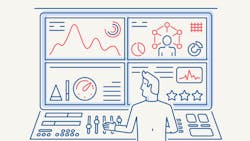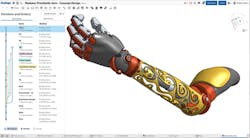Top Trends in Industrial Design: From Green Engineering to the Cloud and Beyond
This file type includes high-resolution graphics and schematics when applicable.
Present in every industry, design engineering plays a leading role in every third of the world’s largest organizations and two-thirds of startups.1
Whether the product is a printed-circuit board, a wind turbine, a duct, or a chair, doing a proper design job is the main focus of every design engineer. But a proper job implies taking the time to sketch, innovate, iterate, and test everything within the specified time frame.
In this entire process, technology is here to make our lives easier, nowadays having software solutions for every step from time- and project-management applications to CAD modeling and simulation. As John Lasseter, one of the three founders of Pixar Animation Studios, puts it, the art challenges the technology, and the technology inspires the art. And this could not be truer than in design.
So what are the main trends in industrial design? Here are the top five:
1. Green products with a focus on energy efficiency.
With more and more people becoming aware of the threats our actions and products pose on the Earth, and global warming being a pressing matter for international organizations and individuals alike, environmentally friendly products might soon be the only products worth developing.
The internet has created a revolution in the way consumers buy, not only through e-commerce, but also with the level of information they can get in seconds prior to making a buying decision. Moreover, consumers are not the only ones aware of their environmental footprint, as manufacturers have a growing interest in reducing energy consumption, using sustainable materials, and minimizing waste.
From LED lights and energy-efficient fans to wind turbines and passive houses, creating eco-friendly designs is becoming the norm.
2. Smart products will rise.
With over 500,000 searches every month, the “Internet of Things” is one of the most popular topics of conversation at the moment. And there is no wonder—IoT is revolutionizing the entire product design world. From consumer goods like watches, home appliances, or automobiles to industrial products such as valves or HVAC equipment, products are becoming smarter.
A smart product is embedded with software, processors, sensors, and connectivity that have the purpose to exchange data between the product and its user, the environment, or other products alike. A few examples of smart products are the Nest thermostat, Amazon Echo, Philips Hue, or the RainMachine.
3. Design for the other 90%.
Of the world’s total population of 7.4 billion, only 10% have access to the products being designed nowadays. But this is about to change. Experts anticipate an increase in products created for those in emerging markets like Southeast Asia and Africa, aimed at finding low-cost solutions for basic needs.
An exhibition at New York City’s Cooper-Hewitt National Design Museum highlights some of them, including the South African Q Drum—a durable container designed to roll easily and transport 75 liters of clean water; a personal mobile water-purification tool; and a pot-in-pot cooler that helps farmers in Nigeria preserve their crops. You can discover more “designs for the other 90%” on the museum’s website.
4. CAD software is moving to the Cloud.
Computer-aided design (CAD) has been essential in product design for decades. And now, CAD software is about to become even better.
On May 4, 2016, Gartner released the “Cool Vendors in Product Design and Life Cycle Management, 2016” report, with the top software vendors we should take a closer look at. A key note in this report is that “the era of cloud-based product design is upon us.”2
Experts worldwide are talking about the shift design engineers are making from on-premises, machine-dependent software to cloud-based solutions. This massive change is driven by the flexibility, collaboration options, ease of use, and massive cost reductions made possible with the Cloud.
According to IDC, about 30% of the enterprise software market will be “software as a service” (SaaS) by the end of 2018.3 So beware, the Cloud is coming.
5. Computer-aided engineering (CAE) software is becoming the norm.
Computer-aided engineering, also known as engineering simulation, involves the use of computer software to simulate, validate, and optimize products in a virtual environment with the purpose of testing and improving them.
CAE software is not a new technology—it has actually been used for more than 50 years. But up until now, it was a privilege reserved only to large companies (especially in automotive and aerospace) that can afford the required investment of $40k+ in hardware and licenses. Just like for CAD software, cloud-based solutions have begun to emerge for simulation, breaking the barriers of traditional on-premises software.
The main advantage of using engineering simulation is that it significantly reduces the design time and costs of physical prototypes while helping create better products by making it possible to validate and test different design variations at the same time. This way, it is easier to predict and achieve energy efficiency, performance, and durability.
Other simulation vendors have also started to offer a Cloud version of their software, acknowledging the fact that the way design teams work together is changing. Having the ability to access your project whenever you need by using any device — desktop computer, laptop, tablet, or mobile phone—and the option to collaborate with your colleagues at the same time are not considered a luxury anymore, but a must. And the Cloud is bringing all of this and more.
As Dr. Marc Halpern stated at the NAFEMS 2016 annual North America conference, in his presentation of the five biggest trends in CAE, “The Cloud is central to everything.”4
Now let us brace ourselves, we are in for quite a ride! As author and Whole Earth Catalog editor Stewart Brand says, “Once a new technology rolls over you, if you’re not part of the steamroller, you’re part of the road.”
Netty Zaharia is Associate Marketing Manager at SimScale.
References:
1. Invision, 2016 Product Design Report.
2. Gartner, Cool Vendors in Product Design and Life Cycle Management, 2016.
3. http://www.idc.com/research/Predictions15/index.jsp.
4. engineering.com, Roopinder Tara, “Be Warned, the CAE World is about to Shift”.




